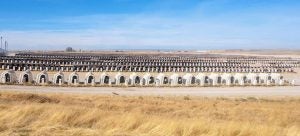Woah …
Have you ever seen pictures like this before? How does this photo make you feel?

If you’re anything like me, with an untrained eye, this photo may make you feel intimidated or uncomfortable. What is going on here? What is with all of these calf huts? Do they really live in these tiny boxes, and how on Earth can they be happy or comfortable?
These are the questions that raced through my mind when I saw this farm and personally snapped this photo.
You see, I wasn’t raised on a dairy farm. I really didn’t know much about the dairy industry before I started my career as an agricultural writer five years ago. So I’ve had to learn over time, and I’ve realized that my eyes have had to be trained to understand the science before jumping to conclusions. Basing views only on what I saw from a distance as opposed to actually getting up close and personal with the animals and the farmer on the farm was disingenuous.
And, boy, is this farm impressive! It belongs to my friend Josh, who farms in the southeastern part of Idaho. Josh and my Dairy Farm friends at Dairy West gave me this fantastic tour, where I was able to see just how well these calves are cared for and why. Each calf is individually bottle fed to know they all get exactly the same amount of nutrients and feed.
After calves are born and licked off, they’re placed in these calf huts to monitor their health and provide top-notch individual care. Think of it like a crib for a baby; a very important and good way to keep an eye on the calves for the first couple weeks or months. This way they know exactly how much each calf is eating, they can be vaccinated, and they know each animals behavior pattern to help out if one may need it, they are safe, warm, and protected.
Have you ever taken your child to school and noticed another kid had a runny nose or was sick? Disease can spread very quickly in the classroom or the workplace. It’s the same idea … by keeping calves from getting in direct contact with other calves, they will not spread any sicknesses.
Sometimes instead of being individually housed like this, some farmers do group housing. Different systems have pros and cons, but group housing may come at a cost. When they’re group housed, say three to eight calves in a larger pen, you don’t always know how much each calf is eating. There’s a greater chance for disease — it isn’t always a better option although it can be done.
When asking Josh if he’d consider group housing, he immediately quipped, “No!” Why? Because he has a 1 percent death loss on the farm. When you’re raising thousands of animals at a time, a 1 percent loss is extremely good. As the old saying goes, “If you have livestock, you’re going to have deadstock,” as animals can die prematurely due to predators, disease, and a host of other factors. By mitigating disease through individual huts for each calf, the farm is much better off. And Josh built an excellent reputation for himself. As the calves grow to be together in the herd, the pens are very clean and well kept; another great way to eliminate problems.
So this is why this farm looks the way it does. I always say … don’t judge a farm by its cover and learn firsthand what is done and why. We may not always know what we are looking at, but by keeping an open mind and allowing ourselves to understand the science, you could just be helping animals in the process.
Michelle Miller, the Farm Babe, is an Iowa-based farmer, public speaker, and writer, who lives and works with her boyfriend on their farm, which consists of row crops, beef cattle, and sheep. She believes education is key in bridging the gap between farmers and consumers.



